Creating your own herbal tea blends lets you enjoy unique flavors and tailored health benefits. You can customize ingredients to fit your taste preferences and wellness goals, whether it's a calming chamomile or a vibrant ginger. The process fosters mindfulness, making it a satisfying self-care activity. Plus, it can save you money compared to store-bought options! Experimenting with different combinations enhances your enjoyment and helps you discover new favorites. If you're interested in tips for choosing fresh ingredients or balancing flavors, there's more to explore in crafting your blends.
Benefits of Herbal Tea Blends

Herbal tea blends offer a delightful way to enhance your well-being. When you create your own blends, you gain control over the ingredients, allowing you to tailor flavors and benefits to suit your preferences. This personalized approach not only makes your experience enjoyable but also boosts the effectiveness of the herbs.
One of the main benefits is relaxation. Ingredients like chamomile and lavender can help calm your mind after a long day. If you're looking for energy, blends featuring ginger or peppermint can invigorate your senses and uplift your mood.
Additionally, many herbs provide health benefits, such as supporting digestion, improving sleep, or enhancing immunity.
Making your own herbal tea blends also encourages mindfulness. As you measure and mix, you engage with the process, fostering a deeper connection to what you consume. This can transform your tea-drinking ritual into a moment of self-care.
Choosing Fresh Ingredients
Often, the quality of your herbal tea blends hinges on the freshness of your ingredients. Fresh herbs and flowers not only enhance the flavor but also offer greater health benefits. When you're selecting ingredients, consider sourcing them from local farmers' markets or growing your own. This way, you can guarantee they're freshly harvested and packed with essential oils and nutrients.
When choosing dried herbs, look for vibrant colors and a strong aroma. If they're faded or lack scent, they've likely lost their potency. Always check the packaging date; the fresher, the better. If possible, buy in small quantities to maintain quality over time.
You might also want to explore seasonal ingredients. Using herbs and flowers at their peak guarantees you're getting the best flavor and health benefits.
Don't hesitate to experiment with different combinations, but remember that fresh ingredients create a more vibrant and healthful blend.
Basic Herbal Tea Ingredients
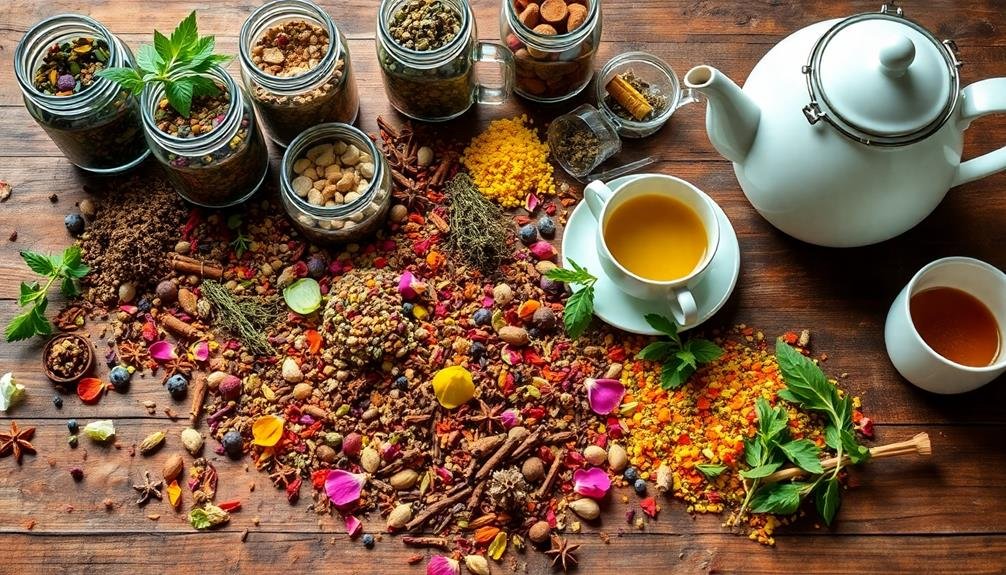
To create a delightful herbal tea blend, you'll want to start with a few basic ingredients that lay the foundation for flavor and health benefits.
First, consider the base herbs. Chamomile, peppermint, and rooibos are popular choices that offer soothing properties and distinct tastes.
Next, think about adding a variety of supporting herbs. Lavender brings a floral note, while ginger adds warmth and spice.
Don't forget about the role of leaves and flowers. Dried hibiscus flowers can provide a tart flavor and vibrant color, while green tea leaves introduce a revitalizing element.
Roots and seeds, like licorice root or fennel seeds, can add sweetness or a unique twist to your blend.
You might also want to incorporate spices. Cinnamon, cardamom, and cloves can elevate your tea with warmth and complexity.
Flavor Profiles to Explore
Exploring diverse flavor profiles can transform your herbal tea experience into something truly unique. When you create your own blends, you can experiment with an array of tastes that suit your preferences.
Start with a base, like chamomile or rooibos, and then layer on flavors that excite you. Consider adding citrusy notes from lemon verbena or orange peel for a bracing zing. If you prefer something sweeter, try incorporating licorice root or dried fruits like apple or pear.
For a more robust profile, blend in spices like ginger or cinnamon to give your tea a warm kick. You can also explore floral notes—lavender and hibiscus can add a delicate touch that elevates your tea.
Don't forget to think about herbal combinations, too. Mint can provide a cooling effect, while lemongrass adds a bright, zesty character.
Balancing Taste and Aroma
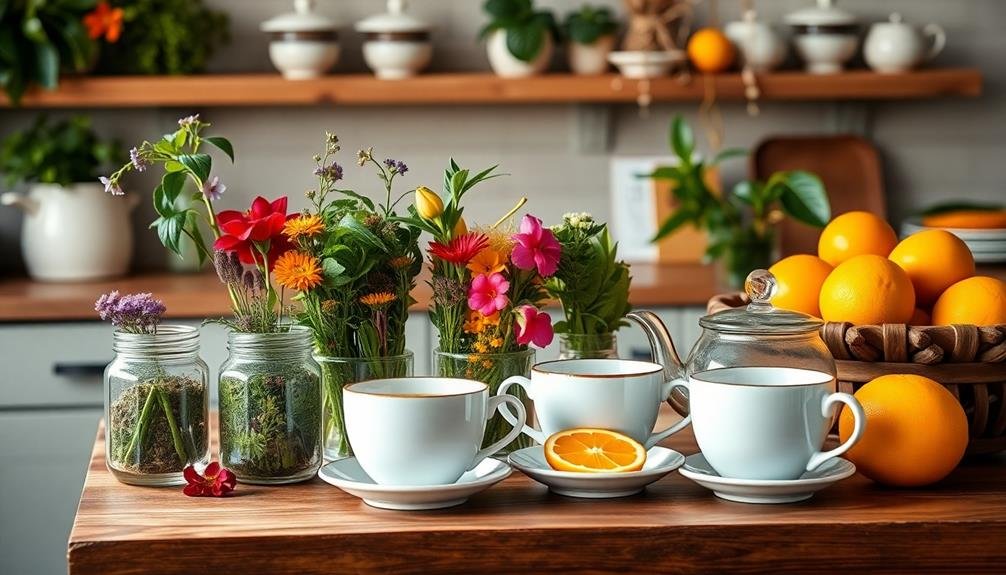
When you're crafting your herbal tea blends, balancing taste and aroma is key to creating a delightful experience.
You'll want to explore various flavor profiles while ensuring aromatic harmony in your mix.
Flavor Profile Exploration
Creating a harmonious herbal tea blend requires a careful balance of taste and aroma, ensuring that each ingredient complements the others. When you explore flavor profiles, think about the primary characteristics of your chosen herbs. Some herbs, like peppermint, offer a revitalizing zing, while others, like chamomile, provide a soothing sweetness.
Start by selecting a base herb that will anchor your blend, then layer in complementary herbs that enhance the overall experience. You'll want to take into account both the taste and aroma of each ingredient. For example, if you choose a bold herb like ginger, pair it with something milder, like lemongrass, to maintain balance.
Don't forget about texture, either; adding a bit of dried fruit can introduce a delightful mouthfeel. Experimenting with different ratios helps you identify the perfect mix. Tasting as you go allows you to adjust and refine your blend, ensuring that no single flavor overpowers the others.
Aromatic Harmony Techniques
Balancing taste and aroma is key to achieving aromatic harmony in your herbal tea blends. When you master this balance, you'll create delightful infusions that not only taste great but also please the senses with their enticing aromas.
Here are some techniques to help you find that perfect blend:
- Identify Key Ingredients: Choose herbs that complement each other in both taste and scent, like mint with chamomile.
- Experiment with Ratios: Play around with different proportions to see how they affect the overall flavor and aroma.
- Consider Aroma Release: Some herbs release their scent more readily than others; adjust your blend to achieve the desired intensity.
- Incorporate Layers: Use multiple herbs to build complexity. For example, pair a floral herb with a spicy one for depth.
- Taste Test: Always brew a small batch first. This lets you assess the harmony before committing to larger quantities.
Pairing Food With Herbal Teas
When pairing food with herbal teas, you'll want to think about how flavors complement each other.
Consider how certain ingredients can enhance the health benefits of both the dish and the tea.
Flavor Complementation Techniques
Pairing food with herbal teas can elevate your dining experience, enhancing both the flavors of the dish and the tea. Understanding flavor complementation techniques can help you create harmonious pairings that delight your palate. Here are some tips to get you started:
- Contrast Bold Flavors: Match strong herbal notes with rich, hearty dishes for balance.
- Highlight Aromatics: Use teas with floral or citrus notes to accentuate fresh ingredients like herbs and vegetables.
- Sweet Meets Savory: Pair sweet teas with savory dishes to create a delightful contrast; think chamomile with roasted veggies.
- Temperature Matters: Serve chilled teas with spicy foods to cool the palate, or hot teas with comfort foods for warmth.
- Ingredient Synergy: Identify common ingredients in your dish and tea, such as ginger in both a stir-fry and a spicy ginger tea.
Experimenting with these techniques will help you discover unique combinations that enhance both your food and your herbal tea.
Health Benefits Synergy
Exploring the synergy between food and herbal teas can greatly enhance your overall well-being. When you pair the right foods with specific herbal teas, you not only elevate the flavors but also amplify the health benefits.
For instance, if you're enjoying a meal rich in iron, consider sipping on peppermint tea. The menthol can help with iron absorption, making your meal even more nourishing.
Similarly, if you're indulging in a spicy dish, a calming chamomile tea can balance the heat, soothing your digestive system. The anti-inflammatory properties of chamomile can help mitigate any discomfort while enhancing your meal's overall impact on your health.
If you opt for citrusy foods, pairing them with ginger tea can provide a delightful complement. Ginger's antioxidants support digestion, while the citrus boosts your immune system.
Seasonal Herbal Tea Ideas
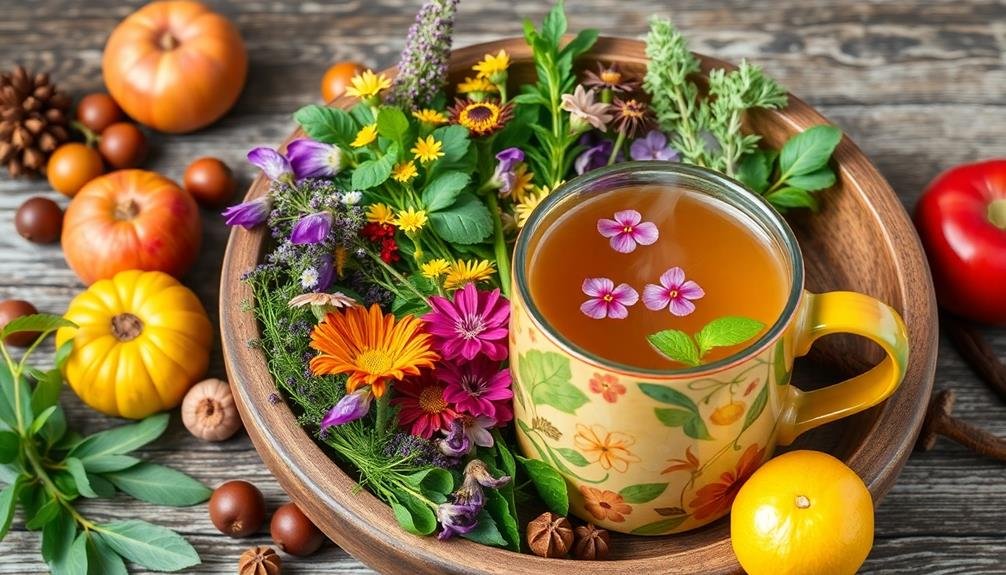
As the seasons change, you can delight your senses by creating herbal tea blends that reflect the flavors and aromas of each time of year.
Seasonal herbal teas not only celebrate nature's bounty but also enhance your mood and well-being. Here are some creative ideas to inspire your blends:
- Spring: Combine chamomile, mint, and lemon verbena for a rejuvenating and uplifting taste.
- Summer: Mix hibiscus, lemongrass, and rose petals for a vibrant, thirst-quenching drink.
- Fall: Use cinnamon, apple pieces, and ginger for a warm, cozy blend that captures autumn's essence.
- Winter: Blend peppermint, elderberry, and licorice root to create a soothing, comforting tea perfect for chilly days.
- Year-Round: Experiment with green tea, lavender, and honey for a versatile blend to enjoy any time.
Creating these seasonal blends not only allows you to savor the unique characteristics of each season but also gives you the chance to experiment with flavors.
Health Benefits of Herbs
Herbs are packed with a multitude of health benefits that can enhance your overall well-being. When you incorporate herbal teas into your daily routine, you're not just enjoying delicious flavors; you're also tapping into nature's medicinal properties.
For instance, chamomile is known for its calming effects, helping to ease anxiety and promote better sleep. If you're looking to boost your immune system, echinacea can provide that support, especially during cold and flu season.
Digestive health is another area where herbs shine. Peppermint can soothe an upset stomach and aid digestion, making it a perfect after-meal drink. Ginger, on the other hand, is great for reducing nausea and inflammation.
Many herbs also have antioxidant properties, which can combat free radicals in your body, promoting overall health. Green tea, for example, is celebrated for its high levels of antioxidants and can even assist with weight management.
Customizing for Personal Preferences
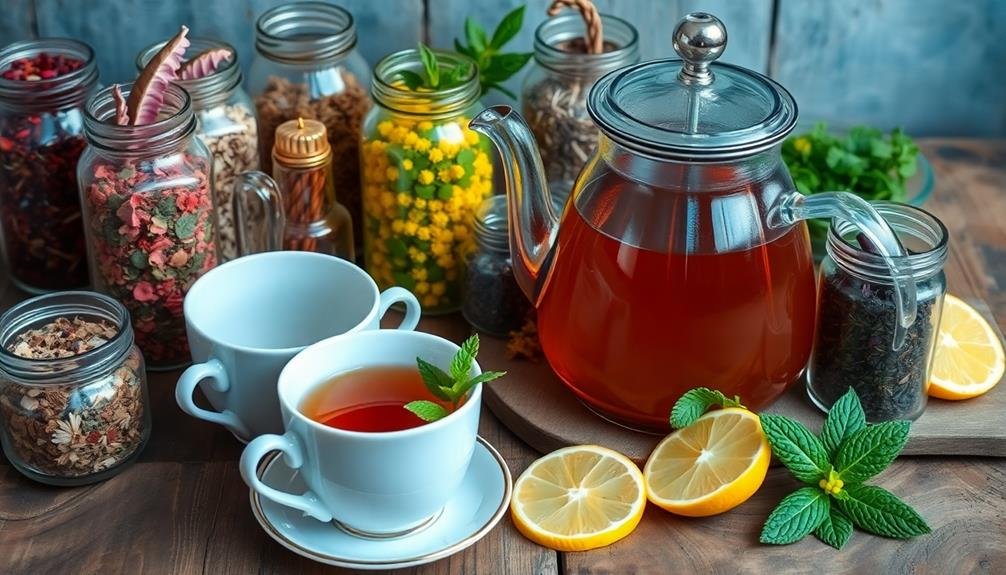
When creating your herbal tea blends, think about what flavors you enjoy most.
You can also select herbs that provide unique health benefits tailored to your needs, and consider using seasonal ingredients for an extra touch.
This way, your tea becomes a reflection of your personal taste and wellness goals.
Tailored Flavor Profiles
Your unique taste can shine through in every cup of herbal tea you brew. Crafting your own blends lets you customize flavors to match your preferences perfectly. You don't have to settle for store-bought options when you can create a brew that reflects what you love.
Here are some ways to tailor your flavor profiles:
- Sweetness: Add dried fruits like apple or pear for a natural sweet touch.
- Spice: Incorporate ginger or cinnamon for a warming kick.
- Herbal Notes: Use chamomile or lemon balm for a calming experience.
- Citrus Zest: Experiment with lemon or orange peel to brighten your blend.
- Earthiness: Include rooibos or hibiscus for a grounding flavor.
Unique Health Benefits
Creating your own herbal tea blends not only satisfies your taste buds but also allows you to harness unique health benefits tailored to your needs. By choosing specific herbs, you can support your body in various ways.
For instance, if you're looking to boost your immune system, you might include elderberry and echinacea. If stress relief is your goal, consider blending chamomile and lavender for a calming effect.
You can also address specific ailments. Ginger and turmeric can aid digestion and reduce inflammation, while peppermint can help alleviate headaches. Tailoring your blend means you're not just drinking tea; you're creating a wellness ritual that aligns with your personal health goals.
Moreover, you can adjust the potency of your blends. If you find that a certain herb works wonders for you, increase its quantity, or if you prefer a milder taste, simply reduce it. This flexibility empowers you to experiment and discover what makes you feel your best.
Seasonal Ingredient Choices
How can you take advantage of seasonal ingredients to enhance your herbal tea blends? By choosing ingredients that are in season, you not only support local farmers but also infuse your teas with the freshest flavors and nutrients.
Seasonal ingredients can personalize your blends, making them more exciting and aligned with your taste preferences. Here are some ideas to contemplate:
- Spring: Fresh mint, chamomile, or lavender for a light, floral touch.
- Summer: Hibiscus, lemon balm, or berries for a revitalizing, fruity infusion.
- Fall: Cinnamon, ginger, or apple for warm, comforting flavors.
- Winter: Peppermint, rooibos, or citrus peels for cozy, soothing brews.
- Year-round: Dried herbs like sage, thyme, or rosemary offer versatility in any season.
Experimenting with these seasonal ingredients will help you discover new favorites and create unique blends that resonate with your palate.
Plus, it's a fun way to connect with nature's rhythms and embrace the flavors each season brings.
Best Tools for Blending
When it comes to blending your own herbal teas, having the right tools makes all the difference in achieving the perfect flavor. Start with a good quality scale to measure your herbs accurately. Precision is key, as even a small change in the proportions can alter the taste considerably.
A mortar and pestle is essential for breaking down tougher ingredients, releasing their essential oils and flavors.
Next, invest in a fine-mesh strainer or tea infuser. This guarantees you get a smooth brew without any floating bits that can detract from your tea experience. If you prefer a more hands-on approach, a dedicated tea blending bowl will give you the freedom to mix ingredients thoroughly while allowing you to see how your blend looks.
Don't forget about storage! A set of airtight containers will keep your herbs fresh and potent.
Storage Tips for Herbal Teas
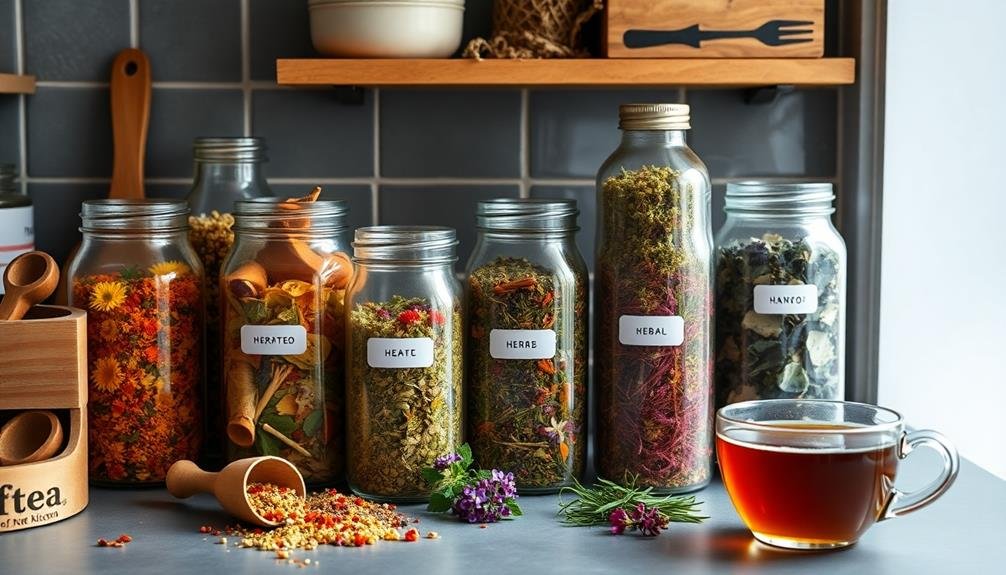
Proper storage is essential for maintaining the freshness and potency of your herbal teas. When you've crafted your own blends, you want to guarantee they stay vibrant and flavorful.
Here are some key storage tips to keep in mind:
- Use airtight containers to prevent moisture and air from degrading your herbs.
- Store in a cool, dark place away from heat sources, which can alter the taste and aroma.
- Label your blends with the date and ingredients, so you can track freshness and easily identify flavors.
- Avoid direct sunlight, as UV rays can diminish the quality of your herbs over time.
- Keep away from strong odors, since herbs can absorb surrounding scents, affecting their flavor.
Sharing Your Custom Blends
Once you've perfected your herbal tea blends and guaranteed they're stored correctly, it's time to share your creations with others. Sharing your custom blends not only spreads joy but also opens the door for feedback and new ideas.
Consider hosting a tea-tasting event where friends can sample your blends. This casual gathering allows everyone to connect and enjoy the flavors you've crafted.
You might also think about gifting your blends in decorative jars. Personalize each gift with a label detailing the ingredients and any health benefits. This thoughtful touch can make your presents memorable and appreciated.
Social media offers another fantastic avenue to share your blends. Post photos and recipes on platforms like Instagram or Facebook, inviting friends to join you in your herbal tea journey. Engaging with a broader audience can spark discussions, leading to collaboration on new blends.
Lastly, join online communities or local herbalist groups. Sharing your experiences and hearing others' stories can deepen your knowledge and inspire creativity in your tea blending.
Frequently Asked Questions
Can I Use Dried Herbs From My Garden for Tea Blends?
Yes, you can definitely use dried herbs from your garden for tea blends! Just make sure they're properly dried and stored. Experiment with different combinations to discover unique flavors that suit your taste. Enjoy brewing!
How Do I Know if My Herbs Are Safe to Consume?
To know if your herbs are safe, research each herb thoroughly. Check for toxicity, potential allergic reactions, and any interactions with medications. It's best to consult reliable sources or a herbalist for guidance.
What Are Common Allergens in Herbal Tea Ingredients?
Common allergens in herbal tea ingredients include chamomile, hibiscus, and peppermint. If you're allergic to plants in the Asteraceae family, avoid chamomile. Always check labels and consult a healthcare professional if you're unsure about specific herbs.
Can Herbal Tea Blends Help With Specific Health Conditions?
Absolutely, herbal tea blends can support various health conditions. You'll find ingredients like chamomile for relaxation or ginger for digestion. Tailoring your blends allows you to address your specific needs effectively and enjoyably.
How Long Do Homemade Herbal Tea Blends Last?
Homemade herbal tea blends typically last about six months when stored in a cool, dark place. To maintain freshness, keep them in airtight containers. Always check for any signs of spoilage before brewing.
In Summary
Creating your own herbal tea blends is a rewarding experience that allows you to explore unique flavors and health benefits tailored just for you. By choosing fresh ingredients and customizing your blends, you can enjoy a cup that truly reflects your tastes and preferences. Plus, sharing your creations with friends and family adds a personal touch to your tea experience. So, grab your herbs, experiment freely, and savor the delightful journey of crafting your perfect herbal tea!

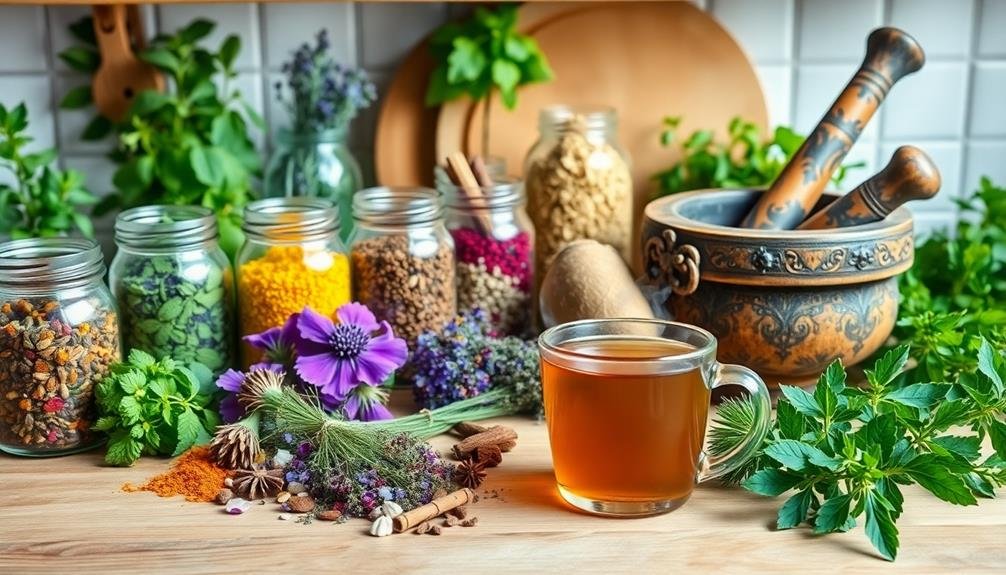



Leave a Reply